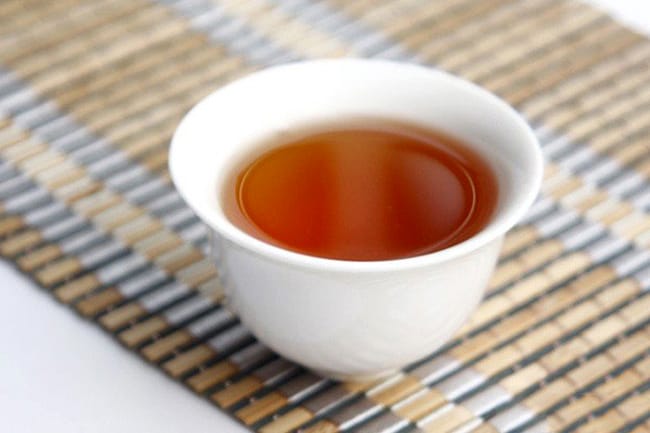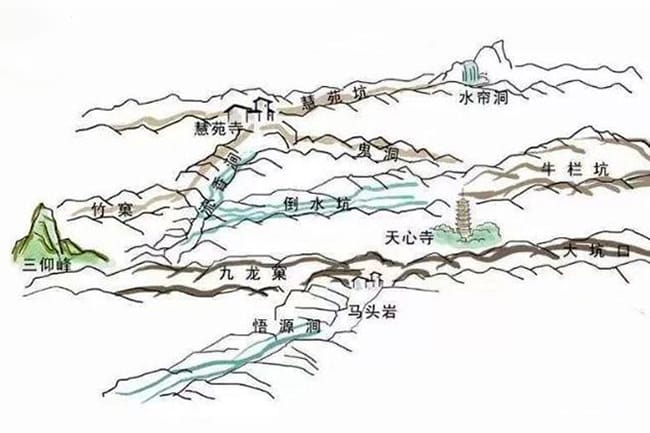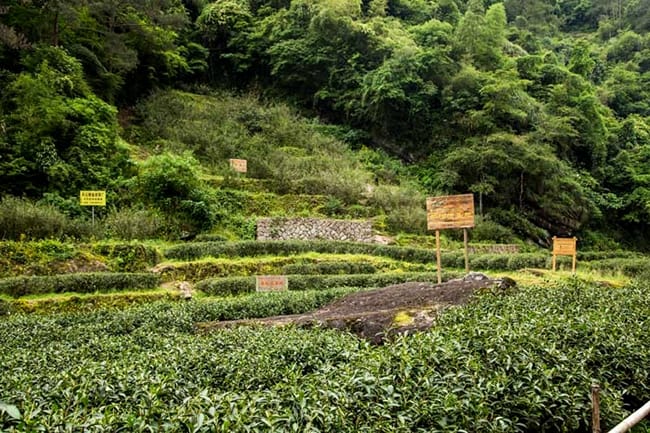Last Updated on 06/12/2023 by Desmond
Fujian’s Wuyi Mountain is a renowned origin of Oolong tea, famously known as the Rock Tea for its distinct “Rock Taste.” The region produces high-quality teas such as Da Hong Pao, Narcissus Oolong, and Rougui tea is also one of the best. Among other rock teas, Rougui stands out with its exceptional flavor and aroma, making it a favorite among tea enthusiasts.

CONTENT
What Is Wuyi Rougui Tea
Rougui is written as “肉桂” in Chinese, the same as the plant spice cinnamon. That’s because Rougui tea has a more pungent aroma and flavor than other ordinary teas, similar to cinnamon.
The earliest record of Rougui tea was in the Qing dynasty‘s local chronicles and poetries. Despite being appreciated during that time, it did not gain much popularity.
During the 1900s, the Fujian government actively encouraged the cultivation of Rougui tea. They focused on creating better Rougui tea tree varieties, provided subsidies and interest-free credit to local farmers to help them expand their production, and heavily promoted the tea. As a result, Rougui tea gained popularity among tea enthusiasts both in China and abroad, then became one of the most popular types of Wuyi Rock Teas.
In Oolong tea circles, there is a popular saying that Narcissus tea is the smoothest and most mellow, while Rougui tea has the most fragrant aroma. Being two of the most well-known Wuyi Rock teas, these two are often compared. However, they both have their own unique characteristics and are not necessarily in competition with each other.
The Narcissus tea tree belongs to Small Tree, and Rougui belongs to Shrub.
The Narcissus tea tree grows tall and lives long. As they grow older, their leaves get better and better flavor. People think they have been through the baptism of wind and rain for decades, and are symbiotic with a full moss environment; thus, they get a unique “Zong” flavor.
Over 60 years old Narcissus tea trees are honored as “Old Trees.” They are rare, so the final products are expensive.
Except for the Narcissus, few tea trees get higher quality leaves as age grows. Most tea trees only have about 20 years of the golden age; unfortunately, Rougui is one of them.
Consideration of Rougui tea was just bulk cultivated and promoted in the 1980s; there can’t be products like “Old Tree Rougui Tea” in the market. Some old tea fans also think that the Rougui tea tastes not as well as the old-time ones in recent years.
Of course, it doesn’t mean that Rougui tea is worse than Narcissus tea; the judgment criteria of their flavor are totally not the same. Surprisingly, the top-grade Rougui teas are typically more expensive than Narcissus tea; we will discuss why later. But that proved Rougui tea is equal in status to Narcissus tea.
How Does Rougui Tea Taste
The feature of Wuyi Rougui tea is focus on its aroma. It’s unlike other teas which are famous for aroma(such as Phoenix Dan Cong, Lu’an Gua Pian, Tieguanyin, etc.) When you close to the cup and smell the Rougui tea steam, you will note a unique smoky of Rock Tea, and an obviously pungent, intense, cinnamon-like fragrance. Maybe there is also a slight, wet wood smell, which is called “Wuyi Sour.” (Some people said that the really top-grade Wuyi Rock Tea wouldn’t send this sour taste.)

Take a sip of hot Rougui tea, the first sense is the unique Rock Taste that fills the oral and wraps the tongue, like inhaling a smooth and moist smoke. But the actual stimulation comes from the following cinnamon-like flavor. A slight spicy goaded the tongue, not as strong as the natural cinnamon. After the mellow tea soup slipped down the throat, a crisp and thick feeling remained on the tongue. The authentic aroma of Rougui tea fills the oral and last long.
We know that most of the tea’s aroma style depends on the roasting way and degree. In order to meet the increasingly diversified market demand, nowadays, tea masters give the leaves different flavors like floral, fruity, and cream, by controlling the baking degree in Rougui tea processing. These flavors mix with Rougui tea’s solid spicy taste, becoming more impact and depth.
Rougui Tea Grades
As mentioned previously, top-grade Rougui tea is very expensive. It typically reaches thousands of dollars per kilo, and it’s also hard to buy through ordinary ways.
The Wuyi tea gardens are concentrated in an area called “3 pits and 2 streams, 三坑两涧,” and divided into multiple smaller regions(AKA grouds). Each of them is in different geographical conditions(like altitude, sunshine duration, humidity, etc.) So the teas they produced are distinctive.

Wuyi Rougui tea is primarily originated from 8 grounds; it also regarded as the graded standard.
- Niu Lan Keng
- Ma Tou Yan
- Jiu Long Ke
- Hu Xiao Yan
- San Yang Feng
- Tian Xin Yan
- Qing Shi Yan
- Zhu Ke
Rougui tea from each ground is distinctive. Every ground’s name contains an animal or its homophonic, and the “Rou” in Rougui means meat in Chinese. Thus, tea fans love to call the Rougui tea a kind of animal meat, depending on the particular ground it is from. For example, “beef” means the Rougui tea from Niu Lan Keng, and horsemeat is from Ma Tou Yan.
Among them, the geographical environment of Niu Lan Keng tea garden is best for Rougui tea growth. The local agricultural research institute has also kept optimizing the tea trees since the 1980s. Thus, the Rougui tea from Niu Land Keng is regarded as the best. Unfortunately, its yield is very low(about dozens of kilos per year,) making it unaffordable for most people.

Of course, except for the planting environment, there also are many factors that influence the quality of Rougui tea. The products from other grounds are also great. Ma Tou Yan Rougui tea is regarded as just second to Niu Lan Keng’s; it has a larger yield and a more reasonable price.
Worthing to know, every ground doesn’t only cultivate Rougui tea but also Narcissus, Da Hong Pao, Shui Jin Gui, etc. As mentioned previously, different tea tree has different environmental demand. It may not produce the best Rougui tea in one tea ground, but it may give excellent Narcissus tea.
How To Brew Rougui Tea
- Prepare a white ceramic Gaiwan, about 110ml;
- Rinse and preheat the teawares;
- Put about 8g Wuyi Rougui tea leaves into the Gaiwan;
- Close the spout to the edge of Gaiwan, circling slowly and fill in 100℃ hot water;
- Cover, steep for 5-8 seconds, then pour out the infusion into the fair cup;
- Enjoy;
- You can extend longer steeping time according to the flavor concentration for each following brew;